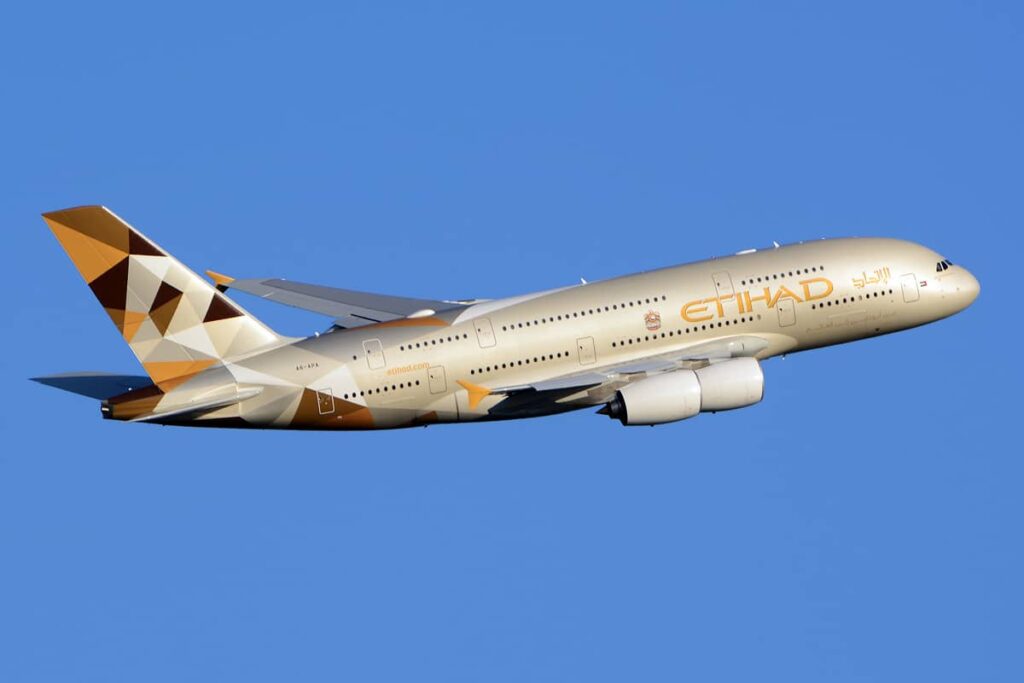Etihad Tests Out Environmentally Friendly Flights
With the introduction of the first commercial flight on 1st January 1914, the global economy became a reality as people could travel to a faraway land with ease and expand their business, move or travel to a foreign land. While air pollution by aviation was not a factor earlier, over a century after the first flight took off, aviation has become a 2.5% contributor to global carbon emissions.
In 2019 United Nations and 81 countries representing 77% of international aviation activity participated and pledged to develop ways to reduce air pollution. As a result of this, Etihad Airways, along with US manufacturer Boeing, introduced the first Eco Flight, which promised lower plastic waste and lower carbon emission. October 2021 was the next step toward eco-friendly flights as Sustainable commercial Flights were launched.
What are Sustainable Flights?
Powered by Boeing’s flagship airliner, the Boeing 787 Dreamliner was the first to be introduced into the elite fleet of commercial aircrafts.
The sustainable flights were equipped with a state-of-the-art flight optimization system, which was responsible for finding the shortest path between origin and destination airport. To increase fuel efficiency, the flights used a mix of jet fuel and biofuel, which reduced the carbon emissions by 70%, which was a major factor in the introduction of hybrid fuel for aviation.
On 23rd October 2021, Etihad Airlines introduced their sustainable flight program in which they used (SAF) Sustainable Aviation Fuel which reduced the carbon emission by 72% and 80%, reduced single-use plastic for food packaging and other accessories shared with passengers on a flight.
What is the Etihad Airways Greenline Program?
Asia’s first Eco-Flight initiative was taken by Abu Dhabi by the introduction of Greenline, the world’s most sustainable commercial flight fleet, where the airport authorities wish to expand the fleet to more sustainable aircrafts. Boeing 787-10 Dreamliner, which served as the earlier version of sustainable aircraft in the year 2021 for Etihad Airways, has undergone significant mechanical and electronic changes which enable the aircraft to operate in the most efficient way possible.
Sustainable Aviation Fuel (SAF) is a special hybrid fuel used for the Greenline; this fuel is a special blend of Aviation Jet fuel and a 38% mixture of biofuel. This is a special grade of biofuel developed for the airlines only; the fuel is synthesized from Salicornia, which is a common plant grown in Abu Dhabi.
Greenline is also equipped with new engineering marvels along with 100% single-use plastic-free, all recyclable material from goodie bags to the food serving trays. Some of the unique features of the green liner include.

Optimized Flight Path:
Greenline, along with Satavia, has generated a flight path forecast where while the aircraft moves to the cruising speed, it can avoid contrails for better engine efficiency. Contrails are condensation trails left by jet aircraft that are formed at high altitudes where jet exhaust gases condense in the low air pressure, and these contrails are one of the major reasons for global warming in recent decades. To avoid these contrails during the flight path, the green liner ensures better efficient engines which have lower carbon emissions.
Continuous Flight Ascend and Descend Paths For low CO2 Emissions:
The Greenline is equipped with one more unique feature where the aircraft is allowed to bypass the ATC guidelines and allows a continuous ascend and descend pattern while taking off and landing the aircraft. Usually, aircraft have a take-off pattern where they keep ascending to 10000 ft and then attain a cruise speed. After maintaining the cruise speed, they again ascend to 39000 ft that the cruising altitude, similarly while descend they make descend to a certain altitude then reduce the aircraft speed, and this descends for landing is done in stages.
This earlier flight pattern was responsible for a lot of fuel consumption and CO2 emission in the lower atmosphere, so Greenline came up with a solution to this issue which was continuous ascend and descend flight patterns. In this, the aircraft takes off and keeps on ascending until it reaches the cruising altitude of 39,000ft. similarly, while descending instead of stage descent, the aircraft follows a continuous descent pattern where the flight keeps on descending till the flight lands. This, along with optimized flight patterns, is responsible for approximately 72% to 80% of CO2 emissions in the lower atmosphere.
No Plastic Policy:
Etihad Airways, with the introduction of the Greenline, took another initiative where they have switched completely to eco-friendly in-flight equipment and food serving dishes. Greenline crew offers Plant-based water bottles which are made from recycled composite plastic material; the dish in which the food is served is made from bamboo base natural material even the food serving trays are made from 100% recycled materials offered alongside with state-of-the-art sharp yet lightweight cutlery.
Hot beverages are served in unique 100% organic, recyclable butterfly cups, which are for single use. This initiative ensures a Zero Single-use plastic flight and has made significant contributions to reducing the post-flight waste to help the environment.
Improved luggage carriers powered by used edible oil as fuel, fuel efficiency program for the whole airport, which includes the ground vehicles as well as other equipment operated using fuel as a power source, is being moved to more sustainable biofuel alternatives.
Greenline, a flagship aircraft with capabilities of reducing single-use plastic to near zero and working on new and improved engines which reduce fuel consumption as well as reduce carbon emission, is going to be the guiding beacon that will help other aircraft and airliners in the industry to become a part of this global initiative taken by Etihad Airways to become the world’s most eco-friendly flight.
Abu Dhabi and Etihad Airways have set an example to the world by presenting Greenline as one of the most environment-friendly commercial flights, which ensures satisfying air travel with ensuring a bright future for the Globe and Humanity as a Whole.
